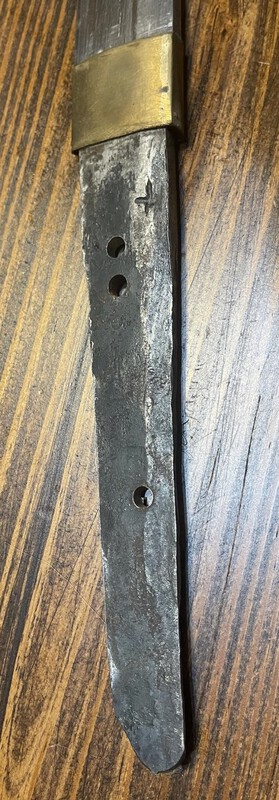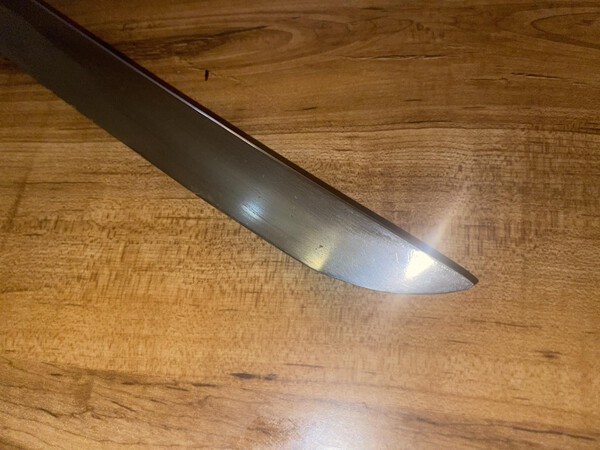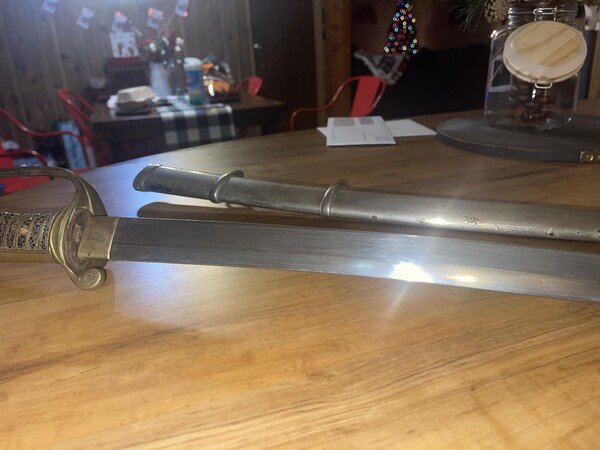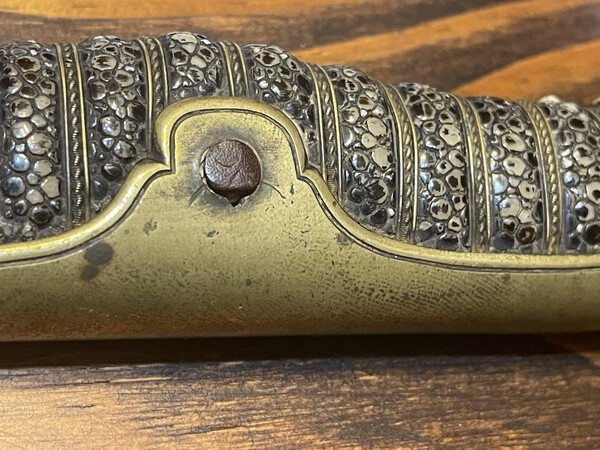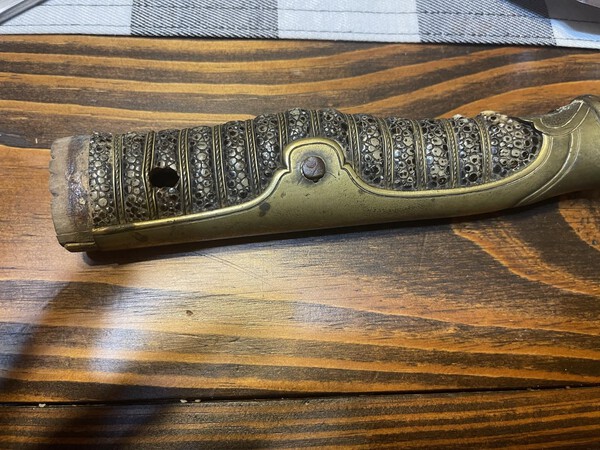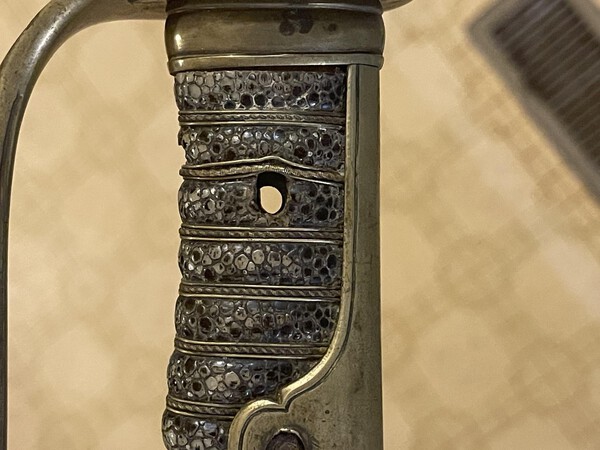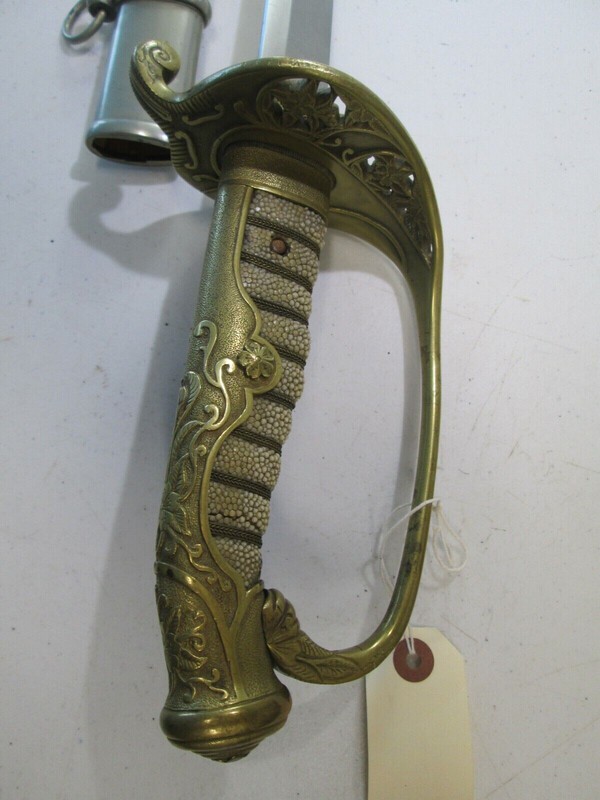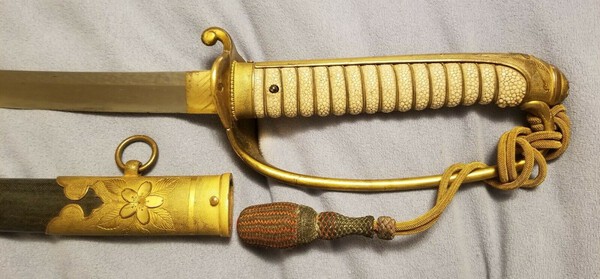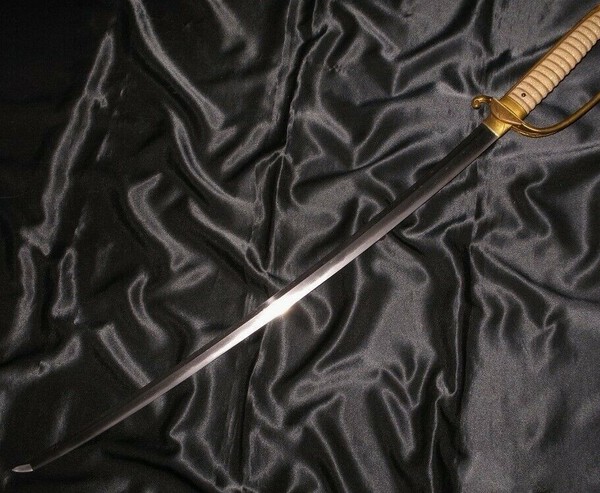-
Posts
1,253 -
Joined
-
Last visited
-
Days Won
8
Everything posted by DTM72
-
A Gassan blade in Kyu mounts with Gassan horimono?
-
.thumb.jpg.bc10b59027a00aa142dce0349f3ba9e0.jpg)
Russo-Japanese type 8 came in today and I’m confused
DTM72 replied to Bridges's topic in General Nihonto Related Discussion
Lastly, I will say, this is NOT a fake kyu-gunto. It is 100% authentic Type 8. It does NOT have the desireable remounted Nihonto as others do. With some quality brass seppa and a good fitting mekugi fitted, this will be a decent outfit. If this is your first Japanese sword, there is not much to learn about nihonto from this. If you paid $500 for it, you did ok. (Not great but not bad) The parade sabers with a chrome plated blade, dull edge and acid etched hamon are selling for $250-$350. Wishing you the best. Dan -
.thumb.jpg.bc10b59027a00aa142dce0349f3ba9e0.jpg)
Russo-Japanese type 8 came in today and I’m confused
DTM72 replied to Bridges's topic in General Nihonto Related Discussion
The Cross type marking looks like katakana (Japanese symbols for sounding out words of foreign origin) I have a smaller one on one of mine that is the katakana symbol for "MO" My blade that has the MO symbol happens to be a Murata blade. 村田刀. Looking at your blade, it looks to be either a Zohito 造兵刀 or a Murata. Zoheito were designed to be a mass produced arsenal blade. Your blade does not appear to have a hamon or jihada so that leads me to believe this is a machine made blade. -
.thumb.jpg.bc10b59027a00aa142dce0349f3ba9e0.jpg)
Russo-Japanese type 8 came in today and I’m confused
DTM72 replied to Bridges's topic in General Nihonto Related Discussion
Looking at the end of your handle core, there is no slot cut into the wood for the release mechanism. Additionally the fuchi does not have a hole for the release button either. Best I can tell, there does not seem to be a square notch in the tsuba (handguard) part of the D-Ring. All that being said, this particular sword was NOT designed to have a release button. So your thoughts of the 2 seppa (spacers) being incorrect, is spot-on. Additional seppa (without the square notch) will be required to tighten-up the tsuka (handle) to the habaki. I may be incorrect but I do not think leather seppa were used on the this type of blade. I have seen them used on the calavry swords and the parade sabers, but not on this type. <-- Not 100% sure on that one. With additional brass seppa, the mounts will tighten-up nicely. <-- easy fix. -
.thumb.jpg.bc10b59027a00aa142dce0349f3ba9e0.jpg)
Russo-Japanese type 8 came in today and I’m confused
DTM72 replied to Bridges's topic in General Nihonto Related Discussion
I'll address your concerns on the items I can help with. Per your pics below, the same' skin was originally painted black, then polished down to remove the high spots. It may feel plasticky to you, but it is 100% real and original to the handle. It also looks as if the original 2 piece brass mekugi was broken/lost so the hole was plugged to keep the backstrap attached to the handle core. Looking closely at the part where the D-Ring inserts into the handle core, the large node of the ray skin are noticable. The hole in the tsuka appears to lin-up well with the hole in the nakago. I would venture to say that the mekugi was crudely fashioned by someone to somewhat do the job of holding things together. True mekugi should be made of susudake (smoked bamboo). This has increased strength properties over just raw un-cured bamboo. But since these are not used as weapons of war any longer, most collectors will get a good bamboo chopstick that is tapered, and insert inside the hole, mark the length, remove and cut length, and file ends repeatedly until the mekugi is flush with the surface on both sides. -
I saw this sold for $1600. <-- not bad for a non-satinless Type 97 in good mounts. Did you get it or pass?
-
Some of the early Type 19's had a traditional bamboo mekugi AND a brass sakura threaded mekugi that goes in that hole. (See pics below) Need to see pics of the nakago to confirm. I owned one like this, but later sold it to someone who made me an offer I could not refuse. The original brass sakura mekugi could have been damaged or lost and a bamboo mekugi inserted. Keep this in mind if you go to remove the tsuka. I agree with Gilles that this is authentic. The parade sabres have a slightly curved handle whereas the nihonto bladed versions have a straight handle to accomodate the nakago. The same' on the handle appears to have been originally black and has worn nicely. The wire wrap is in tact as well. Notice the center belly node of the same' towards the rear of the handle. Tough to tell from the pics, but the shinogi appears to be high and the blade width looks to taper towards the kiaaski (fumbari). Leads me to believe this could be a koto period blade. Again, provided photos leave a bit to be desired. I would be interested to see the nakago to see what the blade really is. Worth $500? I would say yes. This type of mounting (Especially early like this one) is getting harder to find. Perform your due diligence and examine the blade closely for hagire, fukure, and if you can see the hamon at all, look for tiredness. (Hamon dropping off the edge of the blade). On a side note, never could identify the backstrap decorations per F&G, Dawson, or any other ref material. Guessing it's an early version of the field officer grade decoration. All the best.
-
Steve, Looking at the two examples in Slough's book, there are variations between the two shown. The blade pictured shows even a third variation. Gimei? Maybe, maybe not. As has been said on here many times, buy the blade, not the signature. If the blade, and koshirae, speak to you, then buy it. In just my humble opinion, there is not a great benefit to take a mumei Showato or low to mid-grade gendaito and fake a WWII smith's name. All the best.
-
23rd generation Fujiwara Kanefusa made this
-
@Bruce Pennington Found an odd stamped Type 0 on eBay with markings on the back edge of the nakago. Thought you might want to make a note of it. https://www.ebay.com/itm/385245587299?hash=item59b26d2763:g:zNgAAOSwVqVjfR0g&amdata=enc%3AAQAHAAAAoEdFp8wIBZhpzfEgrF5JpmyWrob%2FQSaAqnvL1luznBXiEFAZThSO5YUmnc2YFOy0l1F40r2QMbpswWqnct91GJBY95dXueCRa8ou5ZUlJvVkoWE6uT87pvO7LDgXqdGNF81gOz8qKgxqZHgnGKl2z4KcQ07eBYoFsMuO%2BUjpLw%2B%2Fi4tRJTyQn5p8uFp9nS9UWVYUJrmflgeTxsOk%2F4U4UGc%3D|tkp%3ABk9SR9SK26mZYQ
-
.thumb.jpg.bc10b59027a00aa142dce0349f3ba9e0.jpg)
Japanese Swords Made In China During World War II
DTM72 replied to Kiipu's topic in Military Swords of Japan
Here in the Southern USA, we have "Waffle House". You can get waffles in the North and they are decent. You can get waffles on the West coast but they ruin them with fruit and other crap. All still waffles though. Don't get me started on the taters...scattered, smothered, covered, chunked, diced, topped, peppered, capped, and the newest is countried. -
.thumb.jpg.bc10b59027a00aa142dce0349f3ba9e0.jpg)
Indiana Token Kai
DTM72 replied to ChrisW's topic in Sword Shows, Events, Community News and Legislation Issues
Chris, As a previous resident of Indiana, this is one of the few things I regret about moving far South from there. If I were still a resident, I would 100% attend and participate in the meetings. I feel that you are doing a great service to collectors and helping to spark new interest into our passion/hobby. Looking at the website, I have nothing negative to say, and think it is a great start. Wishing you and the other members great sucess! Dan -
The problem has been from Japan into the USA. the items clear customs, then come-up missing.
-
.thumb.jpg.bc10b59027a00aa142dce0349f3ba9e0.jpg)
WW2 Japanese sword Izumi daijo Fujiwara Kuniteru saku
DTM72 replied to Swords's topic in General Nihonto Related Discussion
It looks to be machi-okuri, but the end of the nakago does not have the normal suriage straight-cut appearance. -
I think he is referring to an Apple Air Tag or other RFID tag.
-
.thumb.jpg.bc10b59027a00aa142dce0349f3ba9e0.jpg)
Photo of sword identification?
DTM72 replied to Misconstrued's topic in General Nihonto Related Discussion
I cringe every time I see this photo. There are other photos of this same guy, holding the same sword with his bare fingers on the blade. Also cringeworthy to see all the swords just stacked on top of eachother. (My kids would be happy to see that I used "cringeworthy" in a sentence.) -
Looks like you will need; habaki (collar) seppa (spacers) tsuba (hand-guard) tsuka (handle) Habaki and tsuka are custom fitted to each blade. Seppa and tsuba can be filed open or punched to close slightly. Best thing you could do is attend a military antique show or a Japanese sword show. Many dealers have extra habaki, seppa, tsuba and tsuka that you can try to fit. Roll of the dice though.
-
looks like Kato Norisada 加 藤 則 貞
-
Much appreciated Bruce! Now to figure out what belt would have been worn with it...
-
Always wanted a Navy Kyu and finally found a nice one. Even has the tassel! NTHK papers say the blade was made in the Eisho era about 1504-1521. attributing it to the Uda Kunimune. Nagasa = 25 1/2". (64.7cm) Blade thickness at habaki is 3/16" (6.77mm) Width at habaki 1" (2.54cm) Width at Yokote is 9/16" (14.2mm) Sori is 3/4" (19mm)
-
弘 道 Thanks Mark! @Mark





